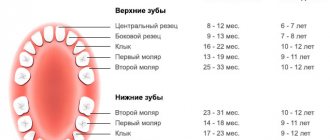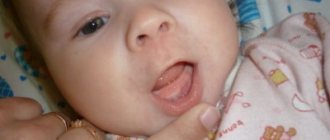How do children's teeth grow? Signs and symptoms.
Excessive salivation
may begin 1-2 months before teeth appear. Along with it, the baby will come with an obsessive desire to bite and gnaw on everything that comes to hand. Make sure they are safe items. A large amount of saliva saves the baby from discomfort during teething. It has been proven that saliva has an antibacterial and analgesic effect.
Tearfulness, anxiety, sleep and appetite disturbances.
New sensations are alien to the child, especially such unpleasant ones as constant itching and pain, even if not always severe. Growing teeth in children can cause them to wake up and cry frequently. Parents can only arm themselves with patience and...knowledge.
Swelling of the gums.
The tooth breaks through to the surface and must break through bone and muscle tissue. Hence the change in the structure of the gums.
Hyperthermia
, or increased body temperature. Temperature changes can range from minor to worrying for parents. Pay attention to how long the temperature lasts. If the high temperature persists for more than three days, you should call a doctor. Only a doctor will determine what caused the hyperthermia: tooth growth or infection.
Runny nose and wet cough.
These symptoms are caused by excessive saliva.
Possible complications during teething
A possible problem may be the absence of teeth for a long time in the presence of teething symptoms. Doctors associate this condition with a lack of calcium in the newborn’s body. It is recommended to check the balance of vitamins and microelements and not introduce new foods into complementary foods.
If the tooth has approached the gum shell, but does not erupt, sometimes the process is helped by surgery. A serious complication is a violation of the pairing of teeth. This is fraught with deformation of the dentition and a broken bite.
The bumps that appear on the gums before eruption are easily injured. An infection can get into the wound, which leads to swelling of the soft tissues, fever, and sometimes suppuration. Parents should ensure that objects that may enter the baby's mouth are sterile. An extensive hematoma is fraught with complications:
- benign formations;
- cyst;
- suppuration;
- compression of adjacent tissues.
Inflammation spreads quickly in children with weakened immunity and poor nutrition. The process can spread to adjacent tissue areas: cheek, face. If the blood inside the hematoma does not resolve, but is retained by a dense membrane of connective tissue, a cyst is formed.
Causes of delayed tooth growth
If the baby is already a year old and still has no teeth, then the parents begin to sound the alarm. Doctors name the following factors that influence the formation of the masticatory apparatus:
- calcium deficiency in children's bodies;
- heredity;
- edentulism;
- hormonal disorders;
- infectious diseases;
- prematurity.
The process of formation of baby teeth ends by age 3. By this age, the child should have 20 teeth. If by 1.5 years you do not observe any signs of tooth growth, consult a doctor.
When do primary incisors appear?
How long it takes for a baby to cut his first tooth
depends on internal and external factors. The process of appearance of primary incisors is affected by genetic predisposition, climate conditions, and the baby’s diet. In girls, they erupt 1.5 months earlier than in boys. If a child’s smile begins to change only at 10 months, this is not considered a violation.
Most often, the first teeth appear on the lower gum, then the upper. The incisors erupt in pairs: if the first “white island” appears, after a few days the second one will be visible. After the first guest, the next molars emerge at intervals of several months.
Important! By the age of one year, the baby already has 8 teeth, 4 on each gum. But this is not the norm; some babies may have only one “white island”. But if by the child’s first birthday the gums are not even swollen, this is a reason to consult a dentist.
Reasons why a baby may have missing teeth:
delayed physical development (rickets);
absence of organ rudiments (edentia);
lack of phosphorus, calcium, vitamin C, D and retinol;
decreased thyroid activity (hypothyroidism).
Some children are born with a number of “white islands”. Doctors advise removing them so that the mother can freely feed the baby with breast milk. The first molar can come out at 4 months, but this may be a sign of a malfunction of the endocrine system.
The order of teething. Table of tooth growth in children
| Teeth | Age |
| Central incisors: | |
| — 2 lower | 6-10 months |
| - 2 top | 7-12 months |
| Lateral incisors: | |
| — 2 lower | 7-16 months |
| - 2 top | 9-12 months |
| Fangs (4 teeth) | 16-23 months |
| Molars: | |
| — 2 lower | 12-18 months |
| - 2 top | 13-19 months |
| Second molars: | |
| — 2 lower | 24-31 months |
| - 2 top | 25-31 months |
The first teeth erupt differently for all children. If your baby is lucky, the first incisor will come out asymptomatically. Some children have a very difficult time with this process, and parents are forced to use medications.
How long does it take to transform a smile?
How long it takes for the first tooth to be cut primarily depends on the characteristics of the baby’s body. First, the gums swell - the first stage. From this moment it may take up to 2 months until the first child appears.
The process of cutting through the painter itself can take from 3 to 7 days. At this time, the crumbs constantly drag everything into their mouths, pressing on the problem area, they relieve the pain. A gentle massage of the gums will help eliminate unpleasant discomfort.
You can use a massager, which can be easily purchased in a network of pharmacies and stores. Gels with benzocaine and lidocaine also help reduce the intensity of discomfort. But first you need to make sure that your baby is not allergic to the active components of painkillers.
Before using the gel, it is recommended to place it in the cold, thanks to which blood circulation is delayed and pain is reduced.
Other simple manipulations will help you cope with discomfort:
- Massage using a special gel-based product. The painters will show up earlier. The medicine is selected taking into account the age of the child. Before using it, you should accurately determine the dosage.
Incision (in extreme situations). The procedure should be performed by a dentist experienced in performing such operations.
Massage the problem area in a circular motion.
Special rubber bands and toys for teething babies. Before use, items must be disinfected or boiled.
Advice! An apple, a bagel, and a carrot are the best helpers for pain relief. But all manipulations are indicated only in the presence of severe discomfort.
If the gums are red and swollen, this does not mean that after a week, the baby will have her first painter. This process may take several months. How long it takes for babies to cut their first teeth, in what sequence and age, does not affect their durability and strength.
If there is constant discomfort or high temperature, you should consult a doctor to eliminate the development of any pathology.
How to deal with teething symptoms?
Pharmacies today sell a huge number of teething aids. These can be pain-relieving gels, ointments, drops. Their action is aimed at relieving inflammation, reducing pain, and alleviating itching and burning sensations. When new teeth grow, it is rarely possible to endure the pain, and then anesthetic gels are used. Pediatricians insist on the need for consultation, as a maximum, and at a minimum, reading the instructions. Many products are not recommended for use before one year of age and can cause unwanted reactions in a child. At the same time, they have a temporary effect.
"Dantinorm Baby" helps to cope with all the main symptoms that occur in children when teething: inflammation of the gums, fever, runny nose, indigestion and tearfulness. The solution is distinguished by convenient dosed packaging. The effect of one dose lasts up to 8 hours, which, when taken three times, provides reliable protection against unpleasant symptoms 24 hours a day.
Where can I buy it?
- Pharmacy zdravcity.ru
- Pharmacy uteka.ru
When babies' teeth grow too painfully, some parents resort to homemade recipes:
- gums using a gauze pad;
- Minimal cooling of the painful area of the gum using a spoon or pacifier;
- Herbal decoctions (requires consultation with a doctor);
- Special teethers, etc.
Symptoms of the appearance of primary incisors
It is difficult to say exactly how long it takes for a child to cut his first teeth, however, parents should know the signs of the appearance of “white islands”. The process of molar growth is accompanied by the following symptoms:
excessive salivation;
sucking foreign objects.
Teething causes anxiety for the baby, manifested by bad mood and constant crying. Due to severe pain, the child sometimes refuses to eat.
Attention! An elevated temperature is not a necessary sign of the appearance of painters; if it does not rise above 37.5 degrees, there is no need to worry. With higher levels, there is a risk of developing a cold due to weak immunity. If the temperature is observed throughout the entire process of incisor growth, you need to visit a doctor.
Caring for baby teeth
Cleaning and care should begin when teeth begin to grow. Caries can easily spread from baby teeth to permanent teeth. It is important to visit the dentist 2-3 times a year. The pediatric dentist will notice changes at an early stage, tell you how children’s teeth grow, in what order, and help you choose a toothpaste. Your teeth will benefit from limiting sweets in your diet, but it is better to add foods rich in vitamins and minerals: fish, seaweed, cottage cheese.
Teaching how to care for your child's teeth is very simple: brush your teeth together, rinse your mouth with water after eating. These simple routines are easy to make fun for kids. And may the appearance of your first teeth bring only joy to your home!
When to see a doctor
You only need to see a dentist in a few cases;
- absence of any dental unit;
- improper tooth formation;
- the presence of a large gap between the central incisors;
- damage to dental tissue;
- the appearance of a black edge on the neck of the tooth.
The symptoms of teething are similar to those of some diseases. We should not forget that the appearance of teeth in humans is a physiological process provided for by nature. If there is a significant deterioration in the child’s well-being and there are doubts that this is related to the teeth, a visit to the doctor is mandatory.
How long does it take to transform a smile?
How long it takes for the first tooth to be cut primarily depends on the characteristics of the baby’s body. First, the gums swell - the first stage. From this moment it may take up to 2 months until the first child appears.
The process of cutting through the painter itself can take from 3 to 7 days. At this time, the crumbs constantly drag everything into their mouths, pressing on the problem area, they relieve the pain. A gentle massage of the gums will help eliminate unpleasant discomfort.
You can use a massager, which can be easily purchased in a network of pharmacies and stores. Gels with benzocaine and lidocaine also help reduce the intensity of discomfort. But first you need to make sure that your baby is not allergic to the active components of painkillers.
Before using the gel, it is recommended to place it in the cold, thanks to which blood circulation is delayed and pain is reduced.
Other simple manipulations will help you cope with discomfort:
- Massage using a special gel-based product. The painters will show up earlier. The medicine is selected taking into account the age of the child. Before using it, you should accurately determine the dosage.
Incision (in extreme situations). The procedure should be performed by a dentist experienced in performing such operations.
Massage the problem area in a circular motion.
Special rubber bands and toys for teething babies. Before use, items must be disinfected or boiled.
Advice! An apple, a bagel, and a carrot are the best helpers for pain relief. But all manipulations are indicated only in the presence of severe discomfort.
If the gums are red and swollen, this does not mean that after a week, the baby will have her first painter. This process may take several months. How long it takes for babies to cut their first teeth, in what sequence and age, does not affect their durability and strength.
If there is constant discomfort or high temperature, you should consult a doctor to eliminate the development of any pathology.
When do primary incisors appear?
How long does it take for a baby to cut his first tooth?
– depends on internal and external factors. The process of appearance of primary incisors is affected by genetic predisposition, climate conditions, and the baby’s diet. In girls, they erupt 1.5 months earlier than in boys. If a child’s smile begins to change only at 10 months, this is not considered a violation.
Most often, the first teeth appear on the lower gum, then the upper. The incisors erupt in pairs: if the first “white island” appears, after a few days the second one will be visible. After the first guest, the next molars emerge at intervals of several months.
Symptoms of the appearance of primary incisors
It is difficult to say exactly how long it takes for a child to cut his first teeth, however, parents should know the signs of the appearance of “white islands”. The process of molar growth is accompanied by the following symptoms:
excessive salivation;
sucking foreign objects.
Teething causes anxiety for the baby, manifested by bad mood and constant crying. Due to severe pain, the child sometimes refuses to eat.
Attention! An elevated temperature is not a necessary sign of the appearance of painters; if it does not rise above 37.5 degrees, there is no need to worry. With higher levels, there is a risk of developing a cold due to weak immunity. If the temperature is observed throughout the entire process of incisor growth, you need to visit a doctor.
Gaps between teeth
Baby teeth that appear in a child under 3 years of age may be located asymmetrically or with spaces between them. This is a normal option if the entire dentition has not yet erupted. As soon as it is fully formed, due to active chewing, all teeth will fall into place. Further, by the age of 6-7 years, when the replacement of baby teeth begins, gaps will again appear between the teeth, since the size of permanent teeth is much larger. The appearance of such gaps should not worry parents.
What can affect?
How long a tooth grows after eruption in most cases depends on:
- hereditary characteristics;
- climatic conditions;
- gender of the baby;
- nature of nutrition.
If a child grows up in a hot climate, then his development processes proceed faster, including along the line of teething.
Scientists have also found that girls' milk teeth erupt faster than boys'. However, by the age of three, the baby already has all twenty baby teeth.
Most often, in a year, the baby already has four upper and the same number of lower teeth erupting in the oral cavity. The eruption of the baby's lower and upper molars appears by the age of eighteen months. At two years old, the baby's upper and lower canines are clearly distinguishable.
The total number of teeth in this case is not thirty-two, but only twenty, since this is precisely the number of teeth of the milk type.
Even though the first teeth are not as strong as permanent teeth, thanks to them the child can chew on many hard objects.
If the process of cutting the first teeth is very late, parents should take the baby to the pediatrician and dentist. These doctors will examine the child’s body and advise parents about possible causes of delays.









